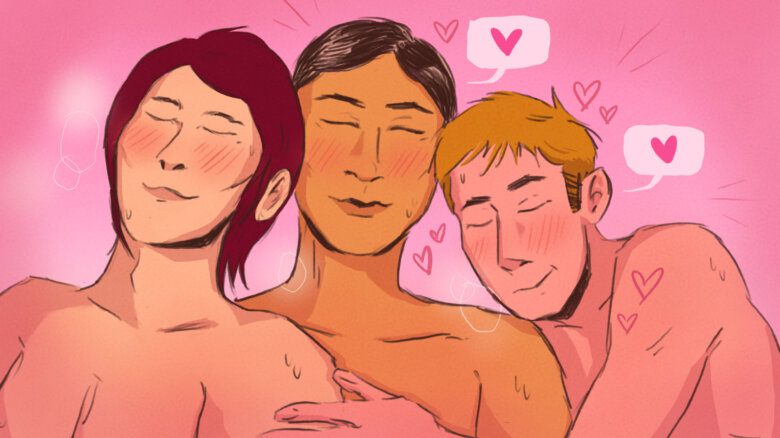It was a quiet weekday at a Hudson’s Bay location in the Greater Toronto Area when a gay Gen Z man went in search of jeans. As he browsed the men’s section, a muscular man looking for a shirt caught his eye. “I seemed to catch his too,” he shares with Xtra on the condition of anonymity.
After he picked a pair to try, he headed to the fitting rooms and noticed the muscular man was as well. “He went in first. I was maybe 15 seconds behind him,” he recalls. “He had his shirt off with the fitting room door open, flexing his pecs. I went into the fitting room, closed the door and got down on my knees. I wasn’t expecting anything when I went.”
While an unexpected encounter for this individual, cruising experiences in department stores are not, but they are dying.
Once symbols of retail innovation, the department store faces extinction. Brands like Eaton’s, Simpsons and Sears were destinations for shoppers up until the mid-20th century, but failed to innovate with changing consumer habits, which has led many to bankruptcy. Now, Canada’s oldest retailer and last true department store, Hudson’s Bay Company (HBC), has announced the liquidation of all its stores.
Department stores have a complex history with the LGBTQ2S+ community. For decades, their bathrooms and change rooms have been sites of connection between men, as well as sites of police surveillance and harassment. Closures do not only impact the retail landscape—they also affect a cruising ecosystem that faces immense pressure.
Cruising is the art of picking up or hooking up with someone in public using non-verbal cues to initiate an encounter. Many call it a form of thrill-seeking and source of anonymous sex; others regard it as an identity-forming experience and highlight its safety aspects, especially when done in outdoor public spaces.
The overall cruising network predominantly includes parks, beaches, university bathrooms, truck stops—and department stores. Word of mouth has remained a constant identifier of these places, but their sources have evolved. Historically, queer media shared these locations like the 1970s gay travel publication Ciao!, which mentions HBC’s Vancouver flagship store. Cruising apps, forums and OnlyFans creators are popular ways to find these spots today.
“If you walk into a bathhouse or a bar to find people, you’re marking yourself … the department store is a way to be anonymous.”
Spatially, department stores create appealing conditions for cruisers. Its apparel sections are segregated by gender, allowing men to congregate inconspicuously, and sexual orientations to remain hidden.
“You’re not marked as a queer person when you go to the department store,” says Olivier Vallerand, associate professor at the school of design at Université de Montréal. “If you walk into a bathhouse or a bar to find people, you’re marking yourself … the department store is a way to be anonymous.”
It also provides an “alibi,” according to Hugues Lefebvre Morasse, co-author (with Gui Tardif) of “Le cruising gai et la spatialité des sexualités” in the essay collection Sexualités et dissidences queers. “A man could just be there wandering … buying a new tie on his lunch break,” he explains.
A history of department store entrapment
“We called them the Bathroom Boys,” a former HBC undercover loss prevention investigator reveals to Xtra, under the condition of anonymity, about cruisers during their employment in the 2000s. While cruising is a discreet art, management caught on to the activities taking place.
Department store bathrooms have been policed for decades. Stores claimed it prevented children from being exposed to acts of “gross indecency.” To curb these activities, locations employed entrapment and surveillance tactics.
Queer publications reported on various stings throughout the 1980s, with HBC being a main perpetrator. Security guards and undercover police lured cruisers into washrooms. Some worked in pairs to avoid suspicion. As The Body Politic (which was published by Xtra’s parent company, Pink Triangle Press) described, “The undercover cop performs well,” noting how they’d pretend to expose themselves, make suggestive motions and arrest victims if they touched the officer’s penis or got hard.
Queer organizations, like advocacy group Gay Committee Council, distributed pamphlets, warning men of the entrapment methods used by security guards and plainclothes officers, while advocacy groups denounced these actions.
“It is one thing to charge people who go out of their way to use the Bay washrooms to cruise, and quite another thing to lure people there for the sole purpose of arresting them. Doesn’t Bay security have better things to do than entrap people?” commented Gens Hellquist of Gay & Lesbian Health Services to the former Prairies-focused gay and lesbian news outlet Perceptions, in regard to a case at a Saskatoon location in 1988.
Bathroom busts, also occurring in theatres and hotels, led to charges of gross indecency, committing an indecent act and committing indecent assault. Some men even had their names and addresses published, putting them, and their families, at risk of shame and potential violence.
Gay Court Watch, which supported LGBTQ2S+ people facing charges, worked to find solutions to prevent men from going to court. In 1983, a judge recommended privately owned enterprises find alternatives to deal with these acts, rather than calling the police.
In addition to charges, those caught were banned from stores. Part of a written notice from HBC that was obtained by The Body Politic in 1983 read: “Should you at any future time enter the premises of the Hudson’s Bay Company, you may be charged with an offence liable up to a fine of one thousand dollars and for the cost of the prosecution, pursuant to the provisions of the (provincial) Trespass Property Act.”
“We could walk up to them and arrest them for trespassing as it’s private property,” the former HBC investigator shares, noting the men’s photos were taken for easy identification.
Lawyer and author of Park Cruising: What Happens When We Wander Off the Path Marcus McCann tells Xtra that individuals in these spaces have “an implied licence or right to attend,” where during opening hours there is an invitation to be on the premises. If a person is caught cruising, that invite can be revoked, meaning that individual is no longer welcome.
In the past decade, McCann says he’s noticed that those engaged in sexual activity in private commercial, non-sexual spaces (a broad category that includes bathrooms in department stores or malls or gym change rooms) will more likely be “given a notice of trespass” instead of being criminally charged. “It can still be extremely embarrassing and sometimes disruptive to people’s lives,” he says.
A shrinking network in suburbia
The cruising ecosystem is under immense strain. High rents (commercial and residential), the soaring cost of living and gentrification threaten how people connect.
McCann writes in his book that increasing commercial rents are causing queer and sex-positive establishments to close, with many not being replaced. High residential rents are another obstacle with many living in multi-person households. These conditions push people to explore sex elsewhere.
“As cruising spaces disappear, pressure is added to existing sites.”
Department stores are important suburban regions where queer spaces were absent. These locations are usually the first to close with remaining ones located in metropolitan cores. The recent closures led one suburban individual on the cruising platform Squirt to ask, “What are you boys going to do?” (Squirt is also run under Pink Triangle Press.)
These locations were easy alibis for those with hidden lives and were spaces during colder months. “When it’s winter in a small town, it’s more of a necessity,” Vallerand says. “It can be the only place.”
As cruising spaces disappear, pressure is added to existing sites. “You are squeezing the number of locations, cruising will get pushed into places that are busier and more visible … it’s in those sites that we tend to see complaints, surveillance and policing,” McCann says.
Unlike the pre-internet era, apps are becoming more useful not just to find other cruisers, but to discover and promote safety. “They’re a good source to find new spots. I glance over the spot prior to going to see if there are any warnings,” says one millennial cruiser from Toronto.
These spaces have been shaped by need, adapted by the queer community who challenged their uses. They were never designed for desire. Their loss will impact queer communities, but cruising spaces will always exist and continue to pop up.


 Why you can trust Xtra
Why you can trust Xtra


